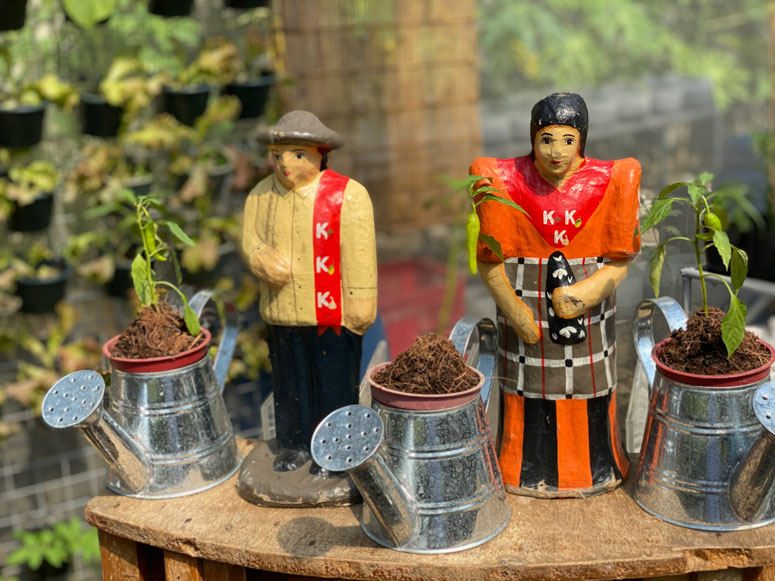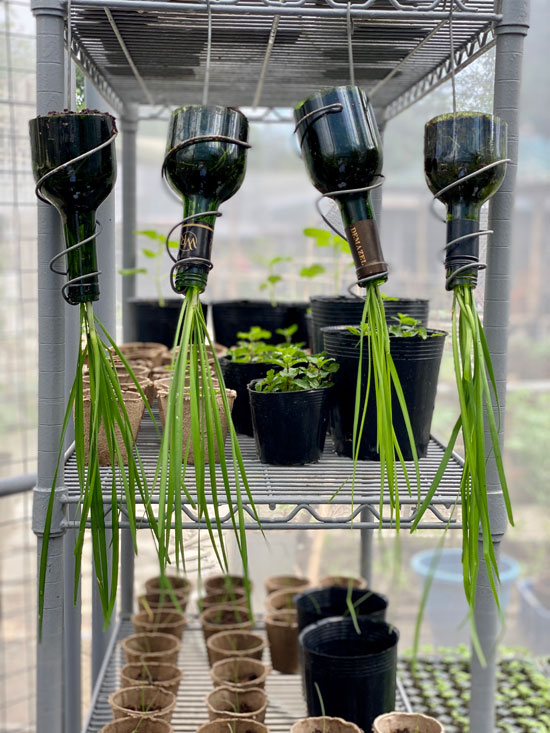How the pandemic changed the life of a jeweler
When Louie Ocampo Gutierrez told his siblings about plans to convert a 500-square-meter property sitting idly next to his Bel-Air Makati home, the response was fraught with caution. The energy and money he would invest in a proper urban farm would be immense. Yet his arrangement with his neighbor, while gratis, would only be for an initial two years. He was told, “It might not be worth it.” Louie’s reply: “If it’s just for two years, so be it. But imagine, they’d be a meaningful and fulfilling two years.”
Louie counts himself as among the many whose lives have been turned inside-out by the virus outbreak. The first few weeks of the Manila lockdown pushed him into a cowering huddle. He had always been a worrier. But the fear at that time, the threat to life, became even more imminent. What will I feed my family? What if our stocks run out? What will happen to my workers? The anxiety eventually turned into an opportunity for introspection.
This is not the business for you if you want to get rich quickly. After all, there are no impatient farmers. It’s for people who are seeking clarity and purpose.
The urge was not to overachieve, to maximize downtime or complete unfinished projects. Realizing he, his wife and four teenage kids would be stuck at home for the unforeseeable future, he thought about seriously growing plants they could actually harvest and serve at the table. They had to eat healthy and not get sick. But the Gutierrezes did not have a rooftop for a garden, or an adequate patch of land for his needs. He looked elsewhere. He just had to peer through his window. Down the street was a property that long been uninhabited. It was all tall blades of cogon.

It was a perfect site for his garden farm. But there was just one complication, the first of many: he didn’t know anything about farming.
The aspiring farmer’s first step was to go to where most of today’s experts started: YouTube. Indeed, everything under the sun is on YouTube. He learned about planting bahay kubo varieties like eggplants, ampalaya, okra. They’re meant for Manila weather — feisty and fruitful even in extremely hot or wet conditions. High-value crops like kale, arugula and lollo roso, not usually hardy enough for insufferable climates like Makati’s, could also give bountiful yield, according to the internet. You’d just need the right agricultural tools and methods, plus some expert help. The last time Louie harvested something he actually ate was back in his Pampanga high school. By some stroke of luck, he grew lettuce on a few square inches of soil during homeroom class. This time he needed technical advice, to show it would work on 500 square meters, off Makati Avenue, of all places.
The expertise could have come from his brother, the famed architect and artist Reimon Gutierrez, who had since taken up organic farming in the Gutierrezes’ Prado Farms in Lubao, Pampanga. The lockdown prevented Reimon from visiting Bel-Air. Louie then turned to Erwin Belen, a UP Los Baños-educated expert in sustainable farming. There was no room for guesswork, for the two years to experiment. Erwin visited the site and found it arable enough. Louie was sure to get Erwin on board after passing the next hurdles: approval from the lot owner and the Bel-Air Village Association.

It was an easy “yes” from the lot owner. She welcomed the idea of putting the idle property to good use. The property clean-up, at Louie’s expense, was also an attractive proposition. His immediate neighbors he convinced as easily. Everything would be nice, pretty, clean, quiet and orderly, he assured them.
The noise, the stench, the bugs, the health of strangers or non-resident workers in the time of COVID, were the same issues raised by the Village Association on July 15, the date of the pitch presentation. Louie was armed with the right answers. What he wasn’t ready for was the shock that greeted him. They found the idea strange, unprecedented.
The pitch revealed a serious enterprise. It would cost a lot of money to set it up and manage it. It was a farm. In a residential village with probably no ampalaya plant in sight. In a city surrounded by concrete. It would be run by a first-time farmer, someone who had been a jeweler for the last 30 years. And it won’t make a lot of money. Why bother, Mr. Gutierrez?

Because the times called for an outlook reset. Because we have learned that we need each other even more, the social distance notwithstanding. Because we need social enterprises. New ways are emerging based on trust, empathy and responsibility. The board bought it.
The approval came through only two weeks after. Louie’s next chapter as a farmer had officially begun. He was ready to realize his vision which he had previously written down as the “Five Pillars of The Urban Farmers of Bel-Air”:
- Maximize the use of idle land.
- Find creative solutions for food and material wastes.
- Create jobs for displaced workers.
- Bring the community together with a common interest in food and gardening.
- Adopt a charitable model from the income to support poor communities and other worthy projects.
He sought to measure the success of his new venture against these five principles. The pillars were also his prayer — that other urban dwellers and landowners would follow suit.

Nowhere in his plans would one see anything relating to profit. Louie quips, “This is not the business for you if you want to get rich quickly. After all, there are no impatient farmers. It’s for people who are seeking clarity and purpose. What else could I do for my family and community? I also wanted to be a more meaningful plantito.”
The interest among Bel-Air residents is growing for a newfound source of organic food and sustainable gardening. It’s turning into a great display of ingenuity and advocacy at a time when sensible living and responsiveness matter
By no means, though, would it be a losing proposition. He needed to make enough money from sales of the produce and by-products like packaged mixed greens and salad dressing to keep the operations going. To supplement their income, Louie would allow his workers to do gardening and clean-up services for residents.
Much of the costs come from labor. He currently employs seven people who were previously working for his silver jewelry business. They were put on furlough after Louie temporarily closed his retail shops. The farm was their way out of unemployment, and their way into a new skill set — possibly even more fun and rewarding.
It didn’t take long for the staff and their boss to feel happy seeing other people happy. Their first harvest for the bahay kubo crops they planted in August were given to the kasambahay and security personnel of the Bel-Air villages, for free. “Never felt that kind of high, seeing them lining up for free gulay. What money can’t buy. We knew we were doing something right. We were on our way to feeding our community well,” Louie intimated.

His farm has also been a showcase for things that would delight climate activist Greta Thunberg. The farm is organic in the truest sense. It’s free of synthetics and chemicals. The equipment, protective gear for plants, pots, props (like broken china and discarded cabinets), and even the bahay kubo at the back of the lot, are all repurposed. The farm and the garden shop look quirky and stylish, so reminiscent of the Ocampo-Gutierrez aesthetic in Prado Farms and their jewelry shops.
It’s only been a brief four months since the first vegetable were planted. But the farm now looks busy, accomplished, full of life, in more ways than one. It’s now home to over 50 plant varieties, both high-value and local. The garden shop sells hundreds of potted herbs like basil, dill, mint, sage, oregano, tarragon; varieties of tomatoes, chili, onion, lettuce, mustard, kale, lime, lemon, edible flowers and so on. In the works is a nursery for oyster mushrooms.
Louie is also eyeing greener pastures beyond his street, on other idle urban properties. On the side he helps others jumpstart their own urban farms, including one in Forbes. Seeing his business model replicated in the other parts of the city excites him as much as seeing the mulch repel the insects that feast on Chinese broccoli.
The Urban Farmers of Bel-Air are going into their fifth month. The interest among Bel-Air residents is growing for a newfound source of organic food and sustainable gardening. It’s turning into a great display of ingenuity and advocacy at a time when sensible living and responsiveness matter. For Louie, it’s proof that his life as an urban farmer — all of five months of it — has been well-lived so far.
* * *
For inquiries and scheduled farm visits, please write to urbanfarmersofbelair@gmail.com.


